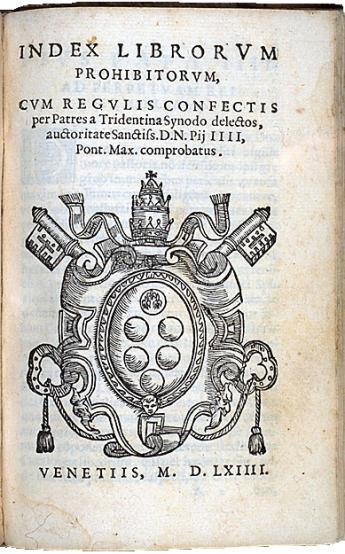Tip
Collecting Rare Books and First Editions - Index Librorum Prohibitorum and The Private Library

By L.D. Mitchell
For a little over 400 years - from 1559 to 1966 - the Roman Catholic Churchproscribed what could and could not be read by the Catholic faithful in a series of lists of prohibited books, the infamous Index Librorum Prohibitorum.
Ostensibly published to guide the faithful away from works of dubious moral value, as well as away from books containing theological errors (as determined by the Church hierarchy), the Index was never a single mammoth list, but rather a series of lists that were compiled under a variety of Popes and church councils.
The first such list, promulgated under the direction of Pope Paul IV, was known as The Pauline Index, while the next list in the series (which was developed by the Council of Trent in response to the perceived harshness of the first Index), was termed the Tridentine Index.
Scanning some of the surviving book collections of centuries past, one suspects that The Index may have served as a sort of handy guidebook to collecting for a certain breed of book collector (including not a few Protestants who could thereby publicly thumb their noses at Catholicism -- a huge number of Protestant authors were listed in the various indices for no other reason than Protestantism's supposed "theological errors"). In any event, the various manifestations of the Index are highly collectible in their own right.
One suspects that some folks today still use the various indices as guidebooks to collecting (might make for an interesting academic research topic). Most indices were divided into three sections: authors whose works were banned in their entirety (perhaps an especially enticing collectible for some Protestant book collectors); authors who had some works banned but not others (perhaps because they had "corrected" a work after an earlier proscription); and topics which were banned as totally unacceptable (many of these were scientific works, but it was not the science that usually got them into trouble with the Church, as much as it was their "heretical," often Protestant, authorship).
As with all such attempts at censorship over the centuries, "mistakes were made." The Polish nun Maria Faustina Kowalska, for example, whose Divine Mercy in My Soul was on the Index for over two decades, was later canonized as St. Faustina. Many of Kepler's works wound up on the Index, as did works by luminaries such as Martin Luther, Immanuel Kant, René Descartes and many, many others. Surprisingly, many works that one might think would definitely be banned by the Index never were--neither Darwin's works on evolution nor Hitler's Mein Kampf were ever added to the Index ...
This collecting is published in The Private Library. It is presented here by permission of the author.
